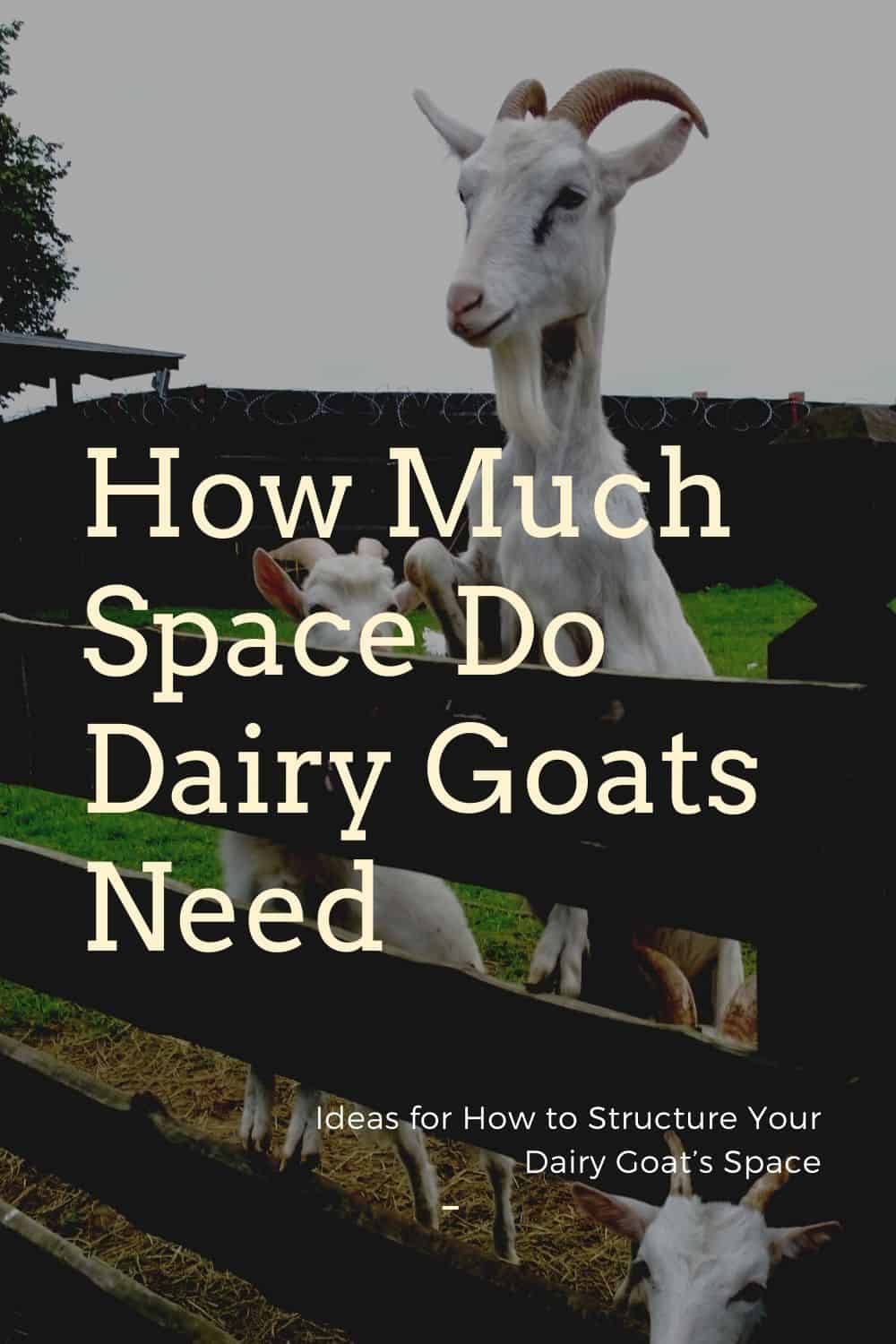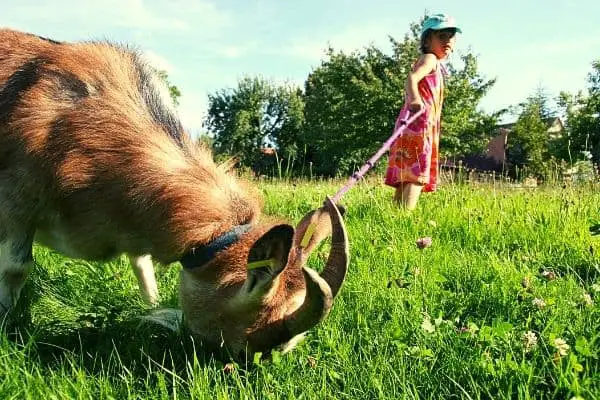Keeping your animal happy is important, especially if you plan on using it for a product like milk. To ensure a happy animal, one thing to consider is space. Therefore, if you are looking to invest in some dairy goats, one of the crucial questions to consider is how much space they will need to thrive.
Typically, you should provide your dairy goats with both an indoor and outdoor space. Each goat will need at least 10 square feet for shelter and 200-250 square feet for grazing and exercise.
It is important to note that the numbers above are the minimum. There are many other factors to consider when deciding how much space to give your dairy goats. Continue reading to learn more about the space needed by dairy goats.

How Much Space Does a Dairy Goat Need?
Like any mammal, dairy goats living without ample exercise and variation can quickly become overweight and depressed, directly affecting their milk’s quantity and quality. Luckily, there are many tips and tricks for ensuring your goats are satisfied even in the most modest spaces.
Some goat owners are fortunate enough to get away with letting their goats roam free on multiple acres during the day. Today, many people do not have the luxury of lush wide-open fields, and no neighbors who may or may not have beloved gardens that goats are likely to destroy.
While individual goats may not objectively need much space, it can quickly add up depending on the type and amount of goats you have. Although you may only want one dairy goat, they are herding animals. As such, whether you own an Alpine or pygmy goat, you must provide space for at least two goats to keep them happy and productive!
Having More Space
As a general rule for any goat, the more space, the better, plus, the more area, the less work there is for you.
Another additional perk to having more space means more free feed. You want your goats to have a varied diet. However, you can optimize the available area, thereby improving quality and efficiency.
Ideas for How to Structure Your Dairy Goat’s Space
While you may envision a herd of goats in a green, grassy pasture, your goats are better off grazing on a weedy stretch of a hillside. Your space, large or small, does not need to be pretty.
Fencing is one way to keep the predators out and the goats in. Again, this area should be at least 200-250 square feet per goat.

The fencing can be basic, but it must be sturdy and well-maintained. Goats are infamous for getting their heads stuck to reach greener pastures, which leaves them vulnerable to attack and injury.
Suppose you are working with an exceptionally tiny, fenced-in space. In that case, you can provide your goats with toys, platforms, and even seesaws to run around and jump on. They are playful creatures, and they will need help to stay entertained all day.

A Few Ways to Set Things Up
Some owners will simply take their goats for walks, training them on a lead as is done with show goats. In a small space, you want to explore all opportunities for exercising your goats. Some ideas are:
Adjust the Space
Adjust a space to have multiple small, fenced-in areas that your goats can alternate between, thus providing time for weeds to grow. Weeds mean free feed, and that means less storage down the line! There is also the added benefit of better avoiding the risk of parasites.
Set up a Runner Line
Set up a runner line that attaches to your dairy goat’s collar, enabling her to run along a designated stretch of land. You can easily move this line periodically to areas that have more vegetation throughout the year.
Whether you own many acres or have only a large backyard for your goats, all owners must ensure that their herd is locked in and secured at night. A secure shelter is an entirely enclosed space of at least 10 square feet per goat, plus room for troughs to store their nightly feed.
Space Needed to Store Dairy Goat Feed
More than any other goats you may own, it is crucial to provide your dairy goats with abundant sources of nutrients. More nutritionally dense food sources like alfalfa and acorns will result in better tasting and healthier milk. Of course, all this food takes up space!
some questions to consider
Will your goats, receive most of their nutrients from the land?
Or
Will you be providing the majority of their feed?
Feed takes up a ton of space. More often than not, your goats will not acquire all of the necessary nutrients they need from the land, especially during the winter months. You must allocate space for troughs, hay, and perhaps even barrels of sunflower seeds and pellets, to name just a few of goats’ favorite nutritional treats.
If your goats are in a smaller fenced area, they will need to have hay provided throughout the day and night. You will also want to ensure that you disperse water sources throughout your goats’ designated grazing area.
Where to Put Your Dairy Goat’s Milking Stall
The milking stall is perhaps the most essential space in your dairy goat’s life. You will want to ensure that this space is quiet and far away from other goats and farm animals so that you and your goat can remain undisturbed during the milking process.

Additionally, your dairy goat’s baby goats, or “kids,” will need to remain separate from their mother at night. Otherwise, come morning, the babies will have drank up nearly all of their mother’s milk!
It is also worth considering where you will store the milk machine if you have one. Then there are the pails, filters, and milk jugs, to name just a few of the items needed to transport and process your goat’s milk.
Space Needed for Storing and Processing Goat’s Milk
Owning dairy goats also means investing in milking and sanitizing equipment, and those take up space. Dairy goats need milking every day to keep up their production levels, and even if you decide to milk each goat by hand, you will need to make room for the many tools of the trade. Of course, this depends on how many dairy goats you want.
A single milking goat can produce upwards of a gallon of milk a day! Even with one goat, the amount of milk can quickly add up. Given that all goat milk must either be cultured or refrigerated, you will need to find a space nearby to store all of your product. You might need to invest in one or two separate refrigerators.
Explore our most popular list of equipment
You may also need to factor in how quickly you can move your product. Goat milk does not stay fresh much longer than two weeks, and in two weeks, one dairy goat can produce 14 gallons. That is enough to overflow even the largest of kitchen fridges. A fully functioning dairy might include:
Then there are all of the kitchen appliances used in making goat products, such as cheese, yogurt, and kefir. The strainers, milk jugs, stirring spoons, curd knives, cheesecloths, and molds can rapidly pile up.
Watch this video on How to Plan your Goat Pen...
Conclusion
Though this may seem daunting at first, owning dairy goats is a fulfilling endeavor. Even with a medium-sized space, a lot can be done and efficiently accomplished. Having a larger yard or pasture will save you money and time.
Still, with a bit of ingenuity and grit, your dairy goats can thrive without needing acres of land. Plus, your friends and family will appreciate what will inevitably lead to many tasty and nutritional goat milk treats throughout the year!
